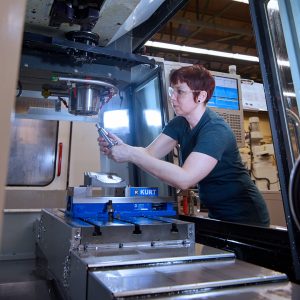The skilled trades have always been a good bet if you’re looking for a well-paid, in-demand career, and that’s going to continue in the years ahead—both in BC and across the globe. Here at home, our import- and export-based economy, abundant natural resources, and thriving metropolitan centres mean that industries ranging from forestry and mining to shipbuilding and transportation are needed more than ever.
Even better, more than a million jobs are projected to open in BC by 2025—part of an ongoing transition as baby boomers continue to retire. Employers are eager to recruit and retain the next generation of skilled workers, and they look to apprenticeship programs to pair them with tomorrow’s talent.
What is an apprenticeship?

We’ve all heard the term “apprentice” and usually define it as someone learning a specific craft. But in the workforce, it’s important to understand that it has a much more specific, technical meaning.
An apprenticeship is a specific type of job training in which you seek a sponsor—typically an employer—to hire you or place you in a paid position so you can learn the tricks of the trade. On top of that, you’re expected to attend an affiliated college, university, or institution part-time, where your instructors are certified journey persons with expertise and experience in your chosen area.
An apprenticeship is not only a great way to earn while you learn, but it also leads to higher income and more career opportunities. Plus, the majority of apprentices in BC are eligible for Employment Insurance benefits during their technical training period.
At the end of the process, workers who trained as apprentices generally outcompete their counterparts in health and safety performance, productivity, and overall quality of work. They’re already equipped with excellent knowledge of the businesses they’ve trained with, and they’ve built relationships with customers. It’s no wonder employers often hire their apprentices—on average, the ROI they receive from training is nearly 50%, or $1.47 earned for every $1.00 spent.
But not all apprentices will work for the organization they trained with. While all programs in BC lead to a Certificate of Qualification for employment in the province, some yield the Interprovincial Red Seal, which opens opportunities nationwide.
How does an apprenticeship work?
All apprenticeships in BC are overseen by the Industry Training Authority (ITA), but first, you have to find a sponsor who will register with the ITA and commit to supporting you, as well as an employer who’s willing to hire you. Usually the organization that hires you also sponsors you—though there are exceptions. For example, a union could sponsor your apprenticeship, and it would then be its responsibility to help connect you with jobs.
When you and your sponsor register your apprenticeship with the ITA, you’ll also select an institution where you’ll complete your technical training. Typically, 80% of an apprenticeship takes place on job sites learning practical, hands-on skills, while the other 20% happens in classrooms and labs to attain the theoretical knowledge needed for your profession. Instead of attending school intermittently, you’ll likely spend a set number of weeks in class per year.
Apprenticeships can take anywhere from one to five years to finish, with four years being the average length. They normally consist of four levels, each of which culminates in an examination administered at your technical training institution by the ITA. At the end of your apprenticeship, the ITA also holds a final exam for all the apprentices in your field, at your level, training at your school—once you pass, you’re a certified tradesperson.
Jumpstart your apprenticeship at BCIT

At BCIT, there is a 98% employment rate for BCIT Apprenticeship completers. BCIT offers several programs that either streamline the process of becoming an apprentice, have apprenticeship opportunities built in, or count towards your technical training.
For example, when you take the Foundation program—which is offered in over 20 trades—you’ll finish your courses with level one, and sometimes level two, of your technical training already complete. Students who have taken the Foundation program are frequently sought by employers, and they come back to BCIT once a year to continue their technical training while they work.
If you’re doing a full-time Diploma program at BCIT, there could be a co-op component where you spend part of your semester training with an external employer. Depending on the particular co-op, this can count toward technical training for an apprenticeship—either level one, level two, or level three, though some co-ops are so comprehensive that they account for all four levels within a single program.
Of course, the Institute also offers standard Apprenticeship Training in more than 20 trades, allowing you to meet with a sponsor and register with the ITA on your own terms, then come to BCIT for your technical training.
Our students’ education is our priority and we will continue to deliver the applied instruction, collaborative experience, and industry connections that students can expect from a BCIT credential. We are developing remote and in-person solutions specific to the unique needs of programs and are taking all measures to ensure the safety and wellbeing of our students, faculty, and staff. Call or email Apprentice Services to learn more about starting your apprenticeship journey at BCIT.
